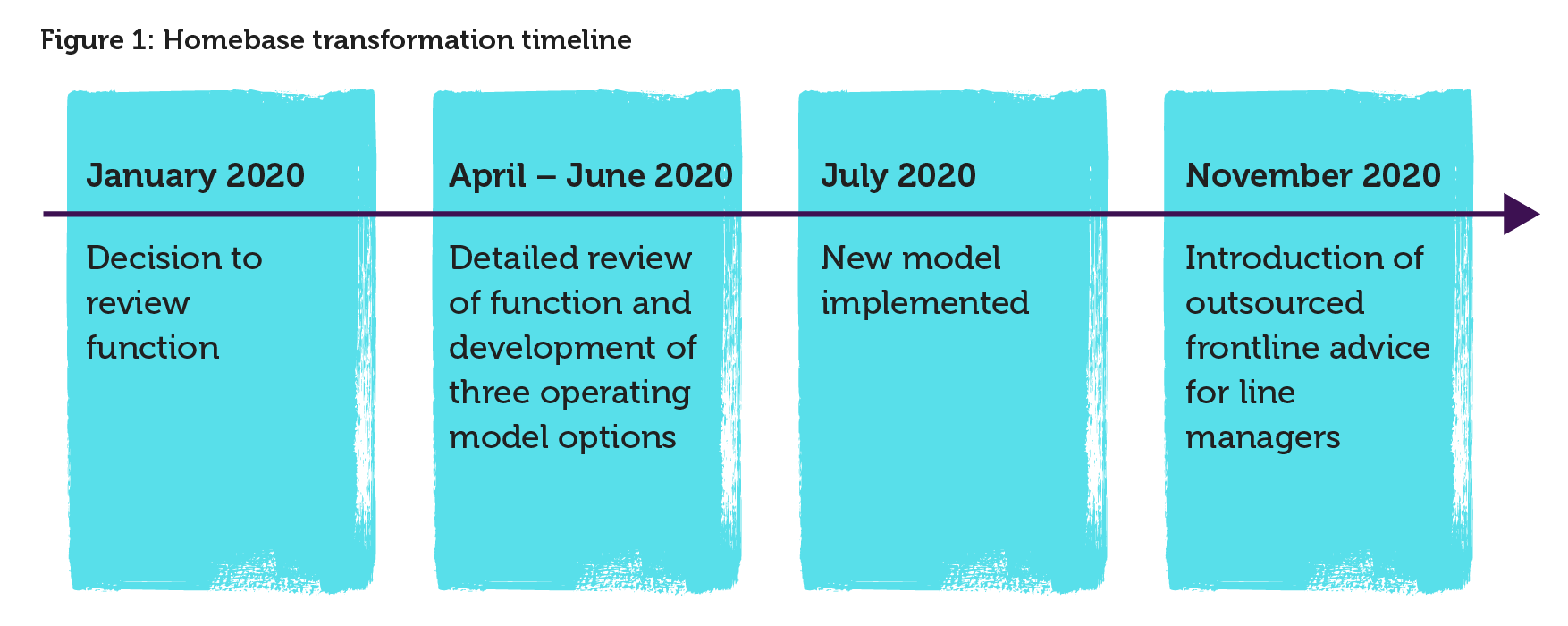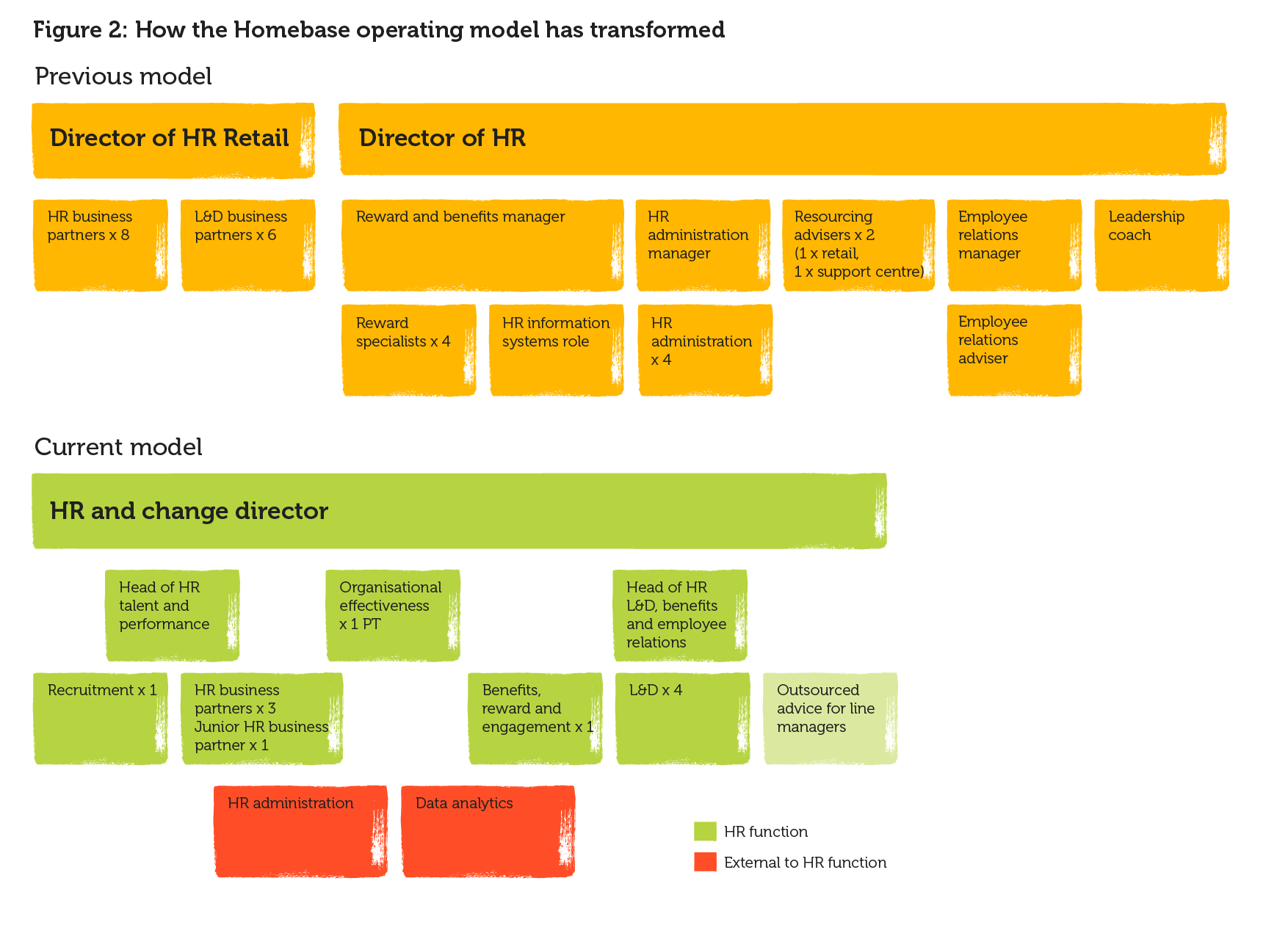Transforming the HR operating model: Homebase
A case study on moving to a lean, strategic HR model that operates more efficiently to support business objectives

A case study on moving to a lean, strategic HR model that operates more efficiently to support business objectives

Homebase is a home improvement retailer and garden centre with stores across the United Kingdom and Ireland. It has approximately 4,500 employees.
In 2018, Homebase was acquired by Hilco Capital, following several changes of ownership since 2016. Although the business had changed considerably since 2016, the HR function had remained largely the same. This prompted a review and transformation of the function in 2020, in order to move to a leaner HR model during the COVID-19 pandemic, and to ensure it was set up optimally to support the business.
“The business had evolved a lot over the previous year or two under a change of ownership, and there was opportunity for the HR team to evolve again and become more aligned to where we were and where we were heading.” Sam Culver, former HR and Change Director
Before the transformation, the HR function consisted of two HR directors aligned to different areas of the business, each with their own people teams (see Figure 2). At times, this led to a lack of cohesion between the two separate functions, with each supporting different priorities, as well as variations in processes, blurred lines of responsibility and duplication of effort.
In addition, the HR business partners (HRBPs) spent a lot of time supporting managers with operational issues such as employee relations casework, rather than focusing on strategic activity. As Lorraine Bray-Cotton, People Change Partner, points out: “This may have had immediate results but doesn’t always drive performance of the longer-term people strategy.”
The transformation began in April 2020, with the aims of:
Sam Culver summarises the desired lean HR operating model as moving from a “high operational support HRBP model to a lean operational support HRBP model, equipping managers and then holding them to account for people management.”
The transformation was led internally by the HR director at the time, implementing a fast-paced model with a high level of change. Lorraine Bray-Cotton explains that this decision was further influenced by the COVID-19 pandemic, where “everyone had to work differently anyway.”
“The conclusion was that, rather than slowly edge towards that model over a few different changes, we should jump to it, be brave.” Sam Culver, HR and Change Director.
To move to the lean, future-ready model, the following changes to the function were implemented in July 2020.

There were several key enablers to ensure the model was implemented and embedded effectively:
Despite the success of the model, a challenge has been ensuring that the HR administration team feels connected to, and part of, the HR function and still has opportunities to develop. To help achieve this:
It’s been successful in helping the team connect, appreciate the work of both sides and have opportunities for learning. Several members of the team have progressed into HR roles, both externally and internally.
The function’s People Plan is key to assessing the effectiveness of the operating model. This is regularly reviewed to see if the operating model enables or inhibits it, informing any required adaptations. In addition, the team tracks key people metrics using a dashboard to understand if they’re moving in the right direction. Additional insight comes from exit interviews and feedback from managers.
Success metrics include the following:
The HR business partners are now working at a strategic level and delivering value-add activity for the business. They now act as ‘thought partners’ for the business’s senior leadership team, and can deliver more effective solutions and support. For example, they have been able to identify and provide insight about skills gaps, which has enabled the L&D team to deliver more effective, tailored development solutions. Lorraine Bray-Cotton explains that: “We’re no longer playing catch up; we’re more frequently part of the [strategic] conversation from the outset.”
Key outcomes of outsourcing the firstline advice for managers include:
Key benefits from merging the HR administration team with the payroll team include:
The team regularly consults with the business and reviews the model, making smaller adjustments in response to changing business needs and priorities. As Sam Culver explains, “The new model might work well now but you can’t assume that will always be the case.”
Recent changes include the following:

Tackling barriers to work today whilst creating inclusive workplaces of tomorrow.

How can people teams balance line managers’ need for operational people management support while growing their team’s strategic influence through the HRBP role?

We look at how investing in digital technologies, HR skills and culture drive success in restructured people functions

A case study of an HR function shifting from an Ulrich+ model towards an employee experience-driven model

A case study of a people function shifting to a four-pillar model to deliver a more consistent employee experience throughout the organisation

A case study of an HR function shifting from an Ulrich+ model towards an employee experience-driven model

A case study of a people function shifting to a four-pillar model to deliver a more consistent employee experience throughout the organisation

A case study on developing strategic partners, aligning teams, increasing data analytics skill, and transitioning the L&D team into an internal academy

A case study on maturing the HR model to align to the changing needs of the business, building capability, and introducing a dedicated team focused on employee engagement